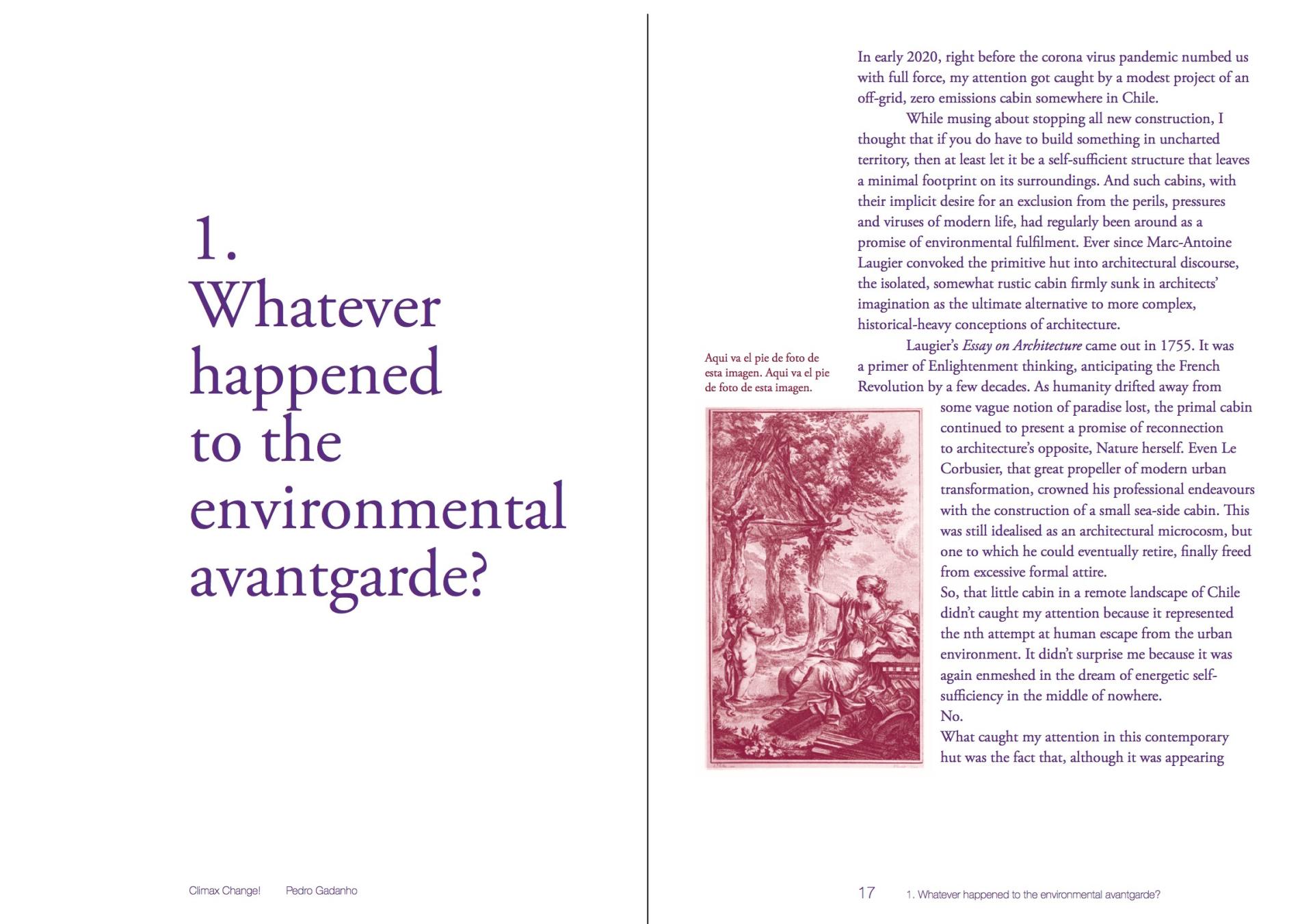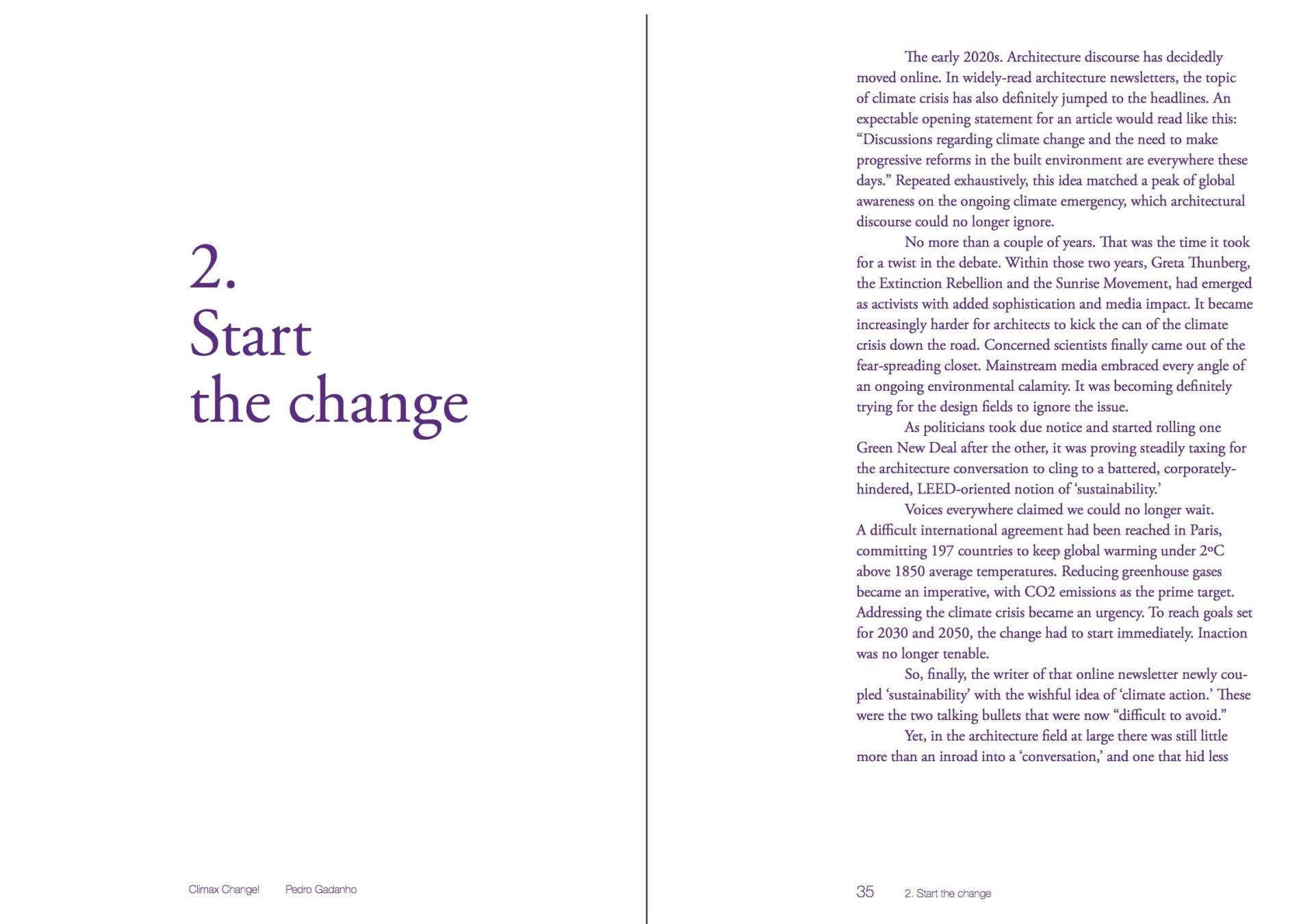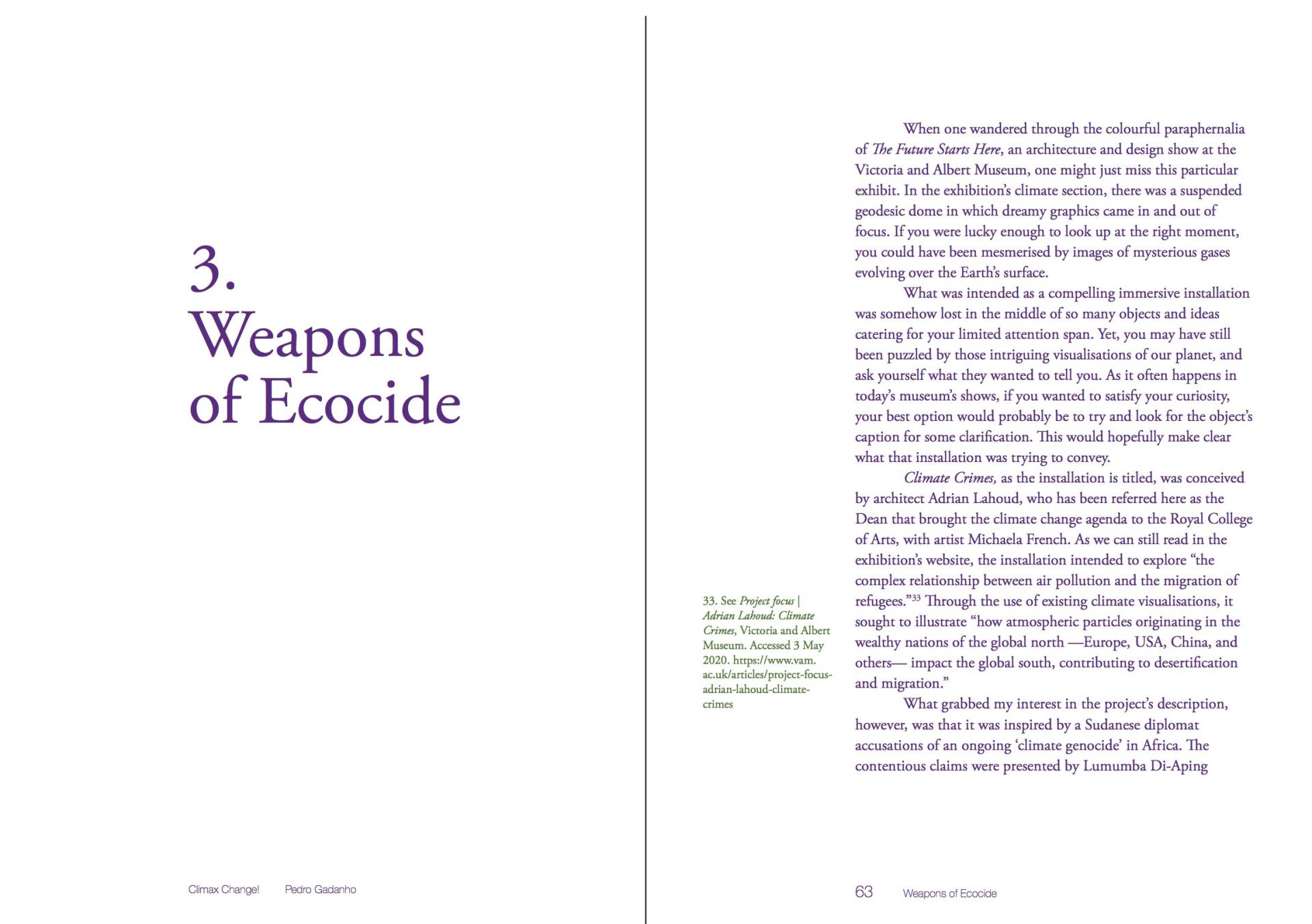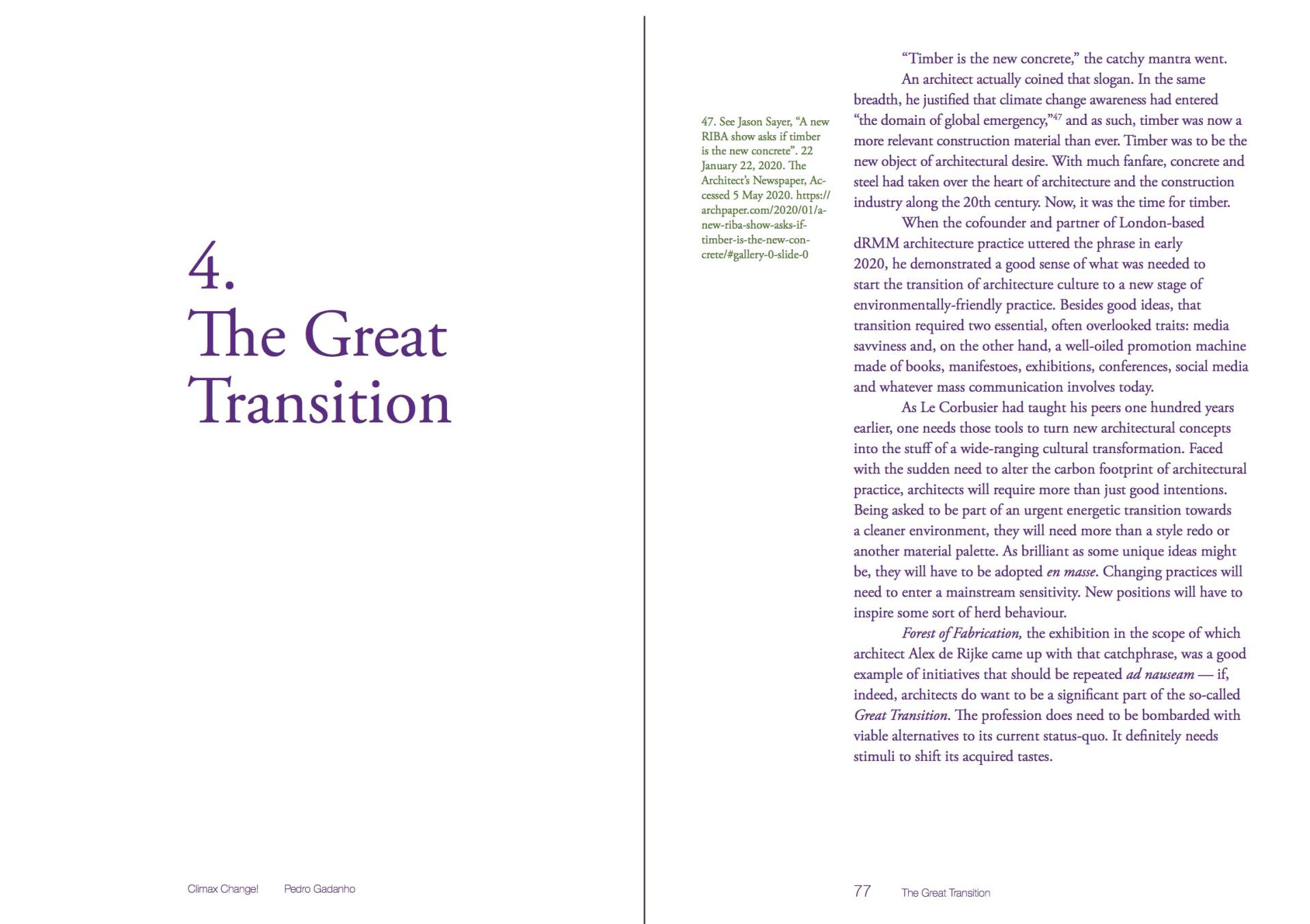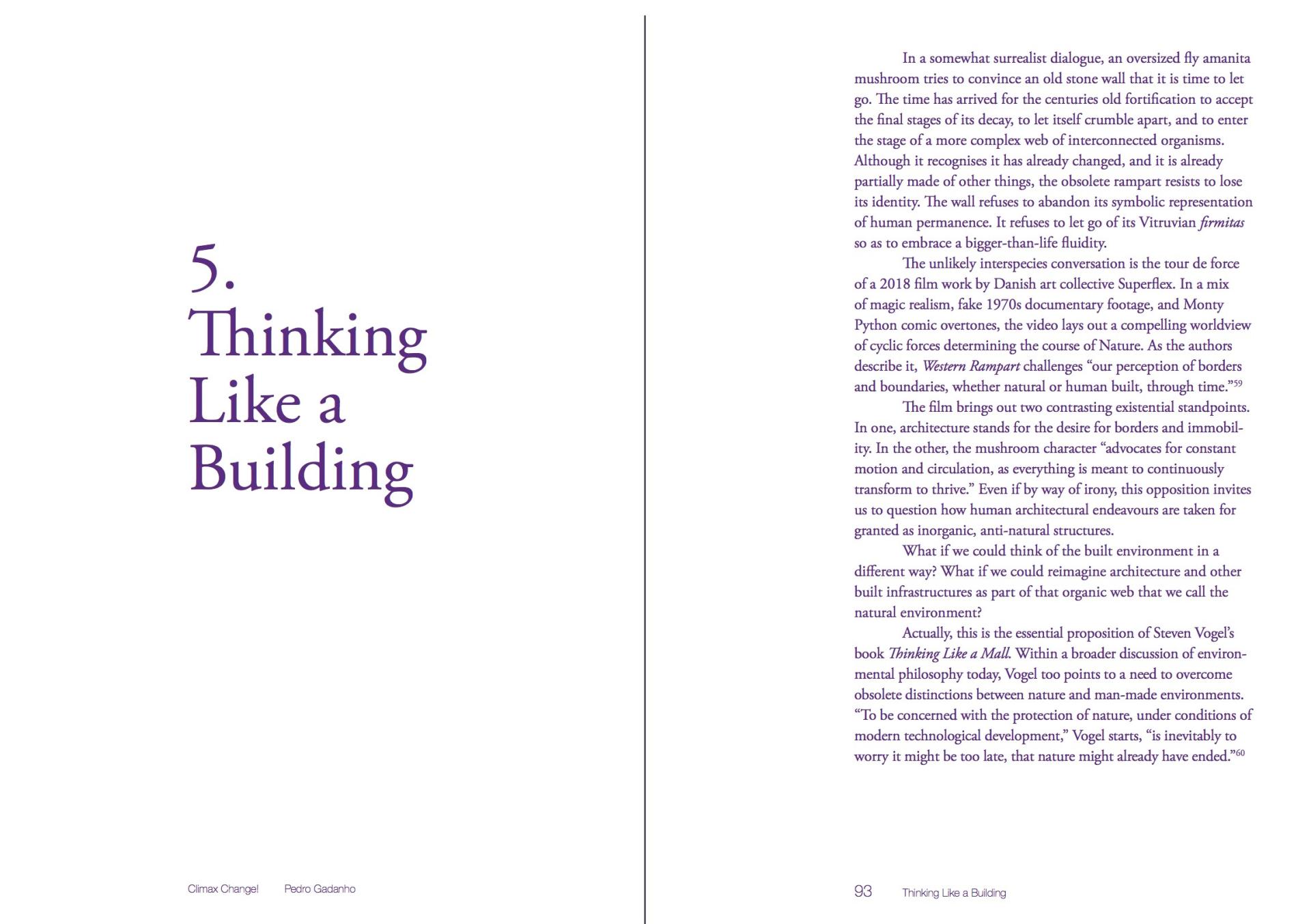Climax Change!
Basic information
Project Title
Full project title
Category
Project Description
The Climax Change! book represents the much-needed overview of how climate change and the current environmental emergency will affect the practice of architecture, both in terms of direct impacts on its design philosophy and of the opportunities to innovate and radically transform the course of the discipline's aesthetic, ethical and professional drives as they stand today.
Project Region
EU Programme or fund
Description of the project
Summary
The Climax Change! book is intended as an up-to-date review of topics of debate related to climate change and the current environmental emergency, specifically as these impact the present and future practice and thinking of architecture and city-making. Beyond technical practices of adaptation and resilience, the book covers the philosophical and professional implications of a necessary process of decarbonization currently facing our societies.
Climax Change! looks at the design options, the materials and the aesthetic shifts that are required for the architecture field to fully participate in the so-called Great Transition – or the implementation of a new energy paradigm that translates into a vision of a just and sustainable global future.
For this, Climax Change! looks at the many possible pathways for architecture practice that, already today, present resilient and adaptive alternatives for ecologically-driven practices of architecture and urbanism, including examples ranging from research into self-sufficiency, large scale upcycling or biomimicry, to the new interdisciplinary interactions required to reposition architecture’s contributions towards new, indispensable balances between the built environment and wider interspecies ecosystems.
Key objectives for sustainability
Climax Change! looks at the challenges and opportunities presented to design fields as political currents turn to the inevitability of adopting Green New Deals as necessary responses to pandemic, economic and ecological crises.
The publication actually looks beyond the current limitations of the sustainability discourse - and posits transformations of practice at a larger and more interconnected scale, advocating for more adequate forms of ecological architecture. These aspects such as changes in material paradigms, energy production within buildings, multispecies and interdisciplinary design, considerations of ecocide, ecosystems services or environmental restoration, among many other topics.
In this direction, Climax Change! actually looks at what is still wrong with the options and musts of architectural practice today, especially when it comes to the historic reliance on unsustainable materials such as concrete and steel, the failure to embrace the visionary insights of environmental avantgardes within the field, or even the lack of academic leadership in addressing a necessary change of the aesthetic and ethic aspirations from which the disciplines of form-making derive their kicks.
Key objectives for aesthetics and quality
Climax Change! calls for a radical change in the overall aesthetics of architecture, advocating that, as much as in early Modernism - and through projects such as the Bauhaus - architects today need again fundamental aesthetic motives so as to change the nature, chosen materials and language of the projects with which they may respond to the ongoing ecological emergency. The climax change that the book advocates for is precisely that of an aesthetic turn, through which environmental concerns become central to architectural thinking and practice.
Beyond the analysis of past relationships and technological connections between architecture and the environment, or the simple response to improvements in functional efficiency, the work is a critical reflection on the current status quo and the opportunities for transformative change.
The publication, currently being designed for a September international launch through ACTAR Publishers, aims to be a game changer. Based on an ample analysis of existing information on the environmental crisis, exploring new technological promises and their risks, situating architectural practice within the logic of coming Green New Deals and the corresponding energy and ecological transitions, the book fundamentally expands the avenues available to architecture and city-making in the reconsideration of their positions within an inevitable societal transformation.
Key objectives for inclusion
Climax Change! is profoundly committed to the idea that the solution to the ecological emergency goes hand in hand with the correction of rising economic and social inequalities.
Climate justice is thus a central topic for the book, reflecting how this idea is today inevitably interlinked with racial justice or more general politics of inclusion. In that sense, many of the solutions and pathways portrayed in the book arise from the Global South, highlighting how responses to the environmental emergency have to be adequate to different political and social contexts.
Results in relation to category
If we are to change the principles of practice of a whole professional class in a very short time, we need cultural manifestoes that bring people together around a shared vision of transformation.
The book intends to be accessible and provocative, aiming at the widest possible architectural audience – thus instilling a call for immediate and equitative climate action within the architectural field. Much as Venturi, Scott Brown and Izenour’s "Learning From Las Vegas" offered a whole generation a new inspiration for design practices based on popular culture, Climax Change! boldly proposes that this is the time for architecture to, much more urgently, learn from the ecological crisis.
In this sense, while the project has already been granted with support from Chicago-based Graham Foundation, the added visibility provided by an European-wide prize such as the one being offered by the New European Bauhaus initiative it will be crucial for more architects and students to hear about the publication and see it as a potential aide for their own preparation for a new kind of practice.
How Citizens benefit
We believe that the success of the book, especially with the right communication strategy behind it, may benefit all kinds of citizens with an accrued knowledge of the dangers at stake in the current ecological emergency - while pointing to the paths that, particularly in the fields of architecture and the built environment, may offer us a way out of a problematic status quo.
The book is intended as an overview of the scientifically-proven implications of an ecological emergency on the construction sector, essentially aimed at architects and architecture students, but is also potentially attractive to other professionals in the building industry.
Given its expansive treatment of environment-related issues and its characterization of the ecological emergency it may also cater for a lay audience who is generally interested in urban and built environment topics, as well as on the extended effects of climate change in everyday life.
Innovative character
Amid the growing publishing crisis, the ambition and innovative aspect of Climax Change! relies in a risky choice and belief: that a book or manifesto can still make a difference when radical change is needed.
Many publications investigating the impact of climate change on architecture assume a partial view, often focusing on discrete technical or material topics, supported by an isolated academic or historical research. While air conditioning or passive energy systems have been newly contextualized for an era of climate action, the field of architecture is still in desperate need of knowledge that offers a critical, overall perspective on the massive diversity of topics that link the current environmental emergency to architecture practices.
In this sense, Climax Change! aims to fill a clear void for those who are coming to the profession and face a lack of systematic and overreaching information on how to conceive architecture in a context of massive decarbonization efforts, a crisis of resources and biodiversity, and other complex aspects of an urgent ecological transition.


